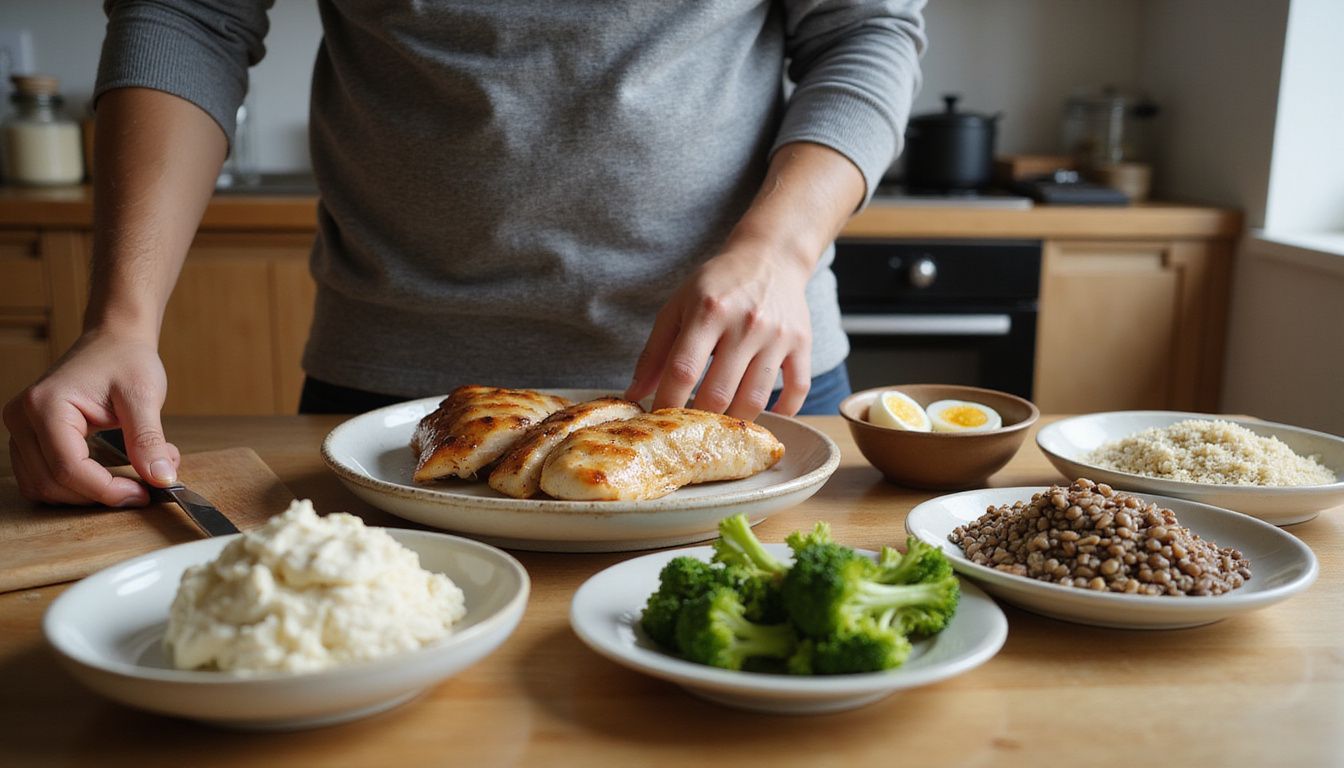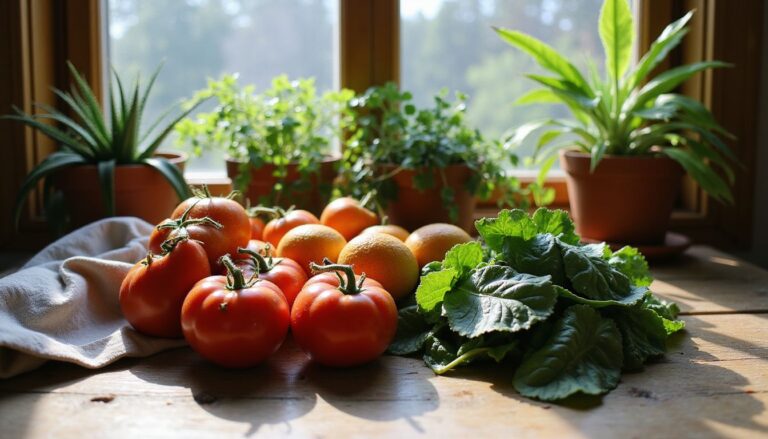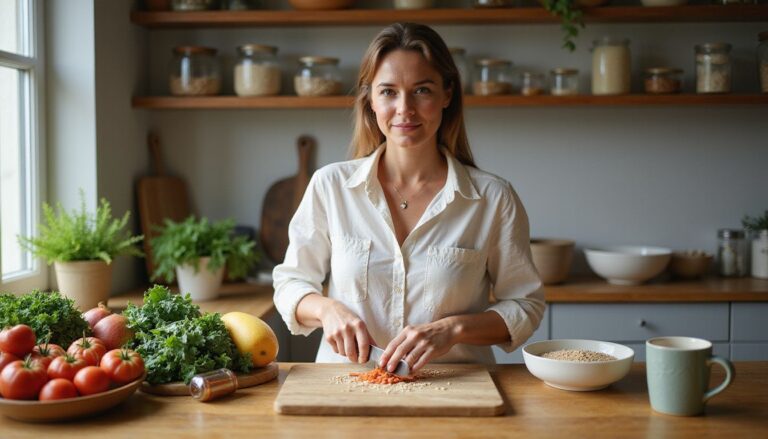Top 6 High Protein Low Calorie Foods For Your Healthy Diet
Our Nutrition Assistant AI Suite will transform your body. You will lose fat, get toned, and build muscle. Gain confidence and optimal health.
Finding meals that help with weight, taste good, and fit a healthy diet can feel tricky. A simple target helps me plan, about 30 grams of protein per meal is often linked with better muscle support and appetite control in a high-protein approach.
After exploring high protein low calorie foods, I found choices that are satisfying and easy to use every day. This guide covers the top six options and practical ways to build high-protein meals that support your goals.
Keep reading for steps you can start today.
Key Takeaways
- High protein, low calorie foods like skinless chicken breast, Greek yogurt, lentils, egg whites, tofu, and white fish support weight control, keep you full longer, and help protect lean muscle.
- Three ounces of skinless chicken breast provide about 26 grams of protein, less than 3 grams of fat, and almost no carbs.
- One cooked cup of lentils offers about 18 grams of protein and 15 grams of fiber with roughly 230 calories.
- Most adults need at least 0.8 grams of protein per kilogram of body weight daily. People who train hard may need up to 2.0 grams for muscle maintenance.
- Plant proteins like tofu and lentils may lack one or more essential amino acids. Pair different sources, such as beans and grains, to make a complete protein.
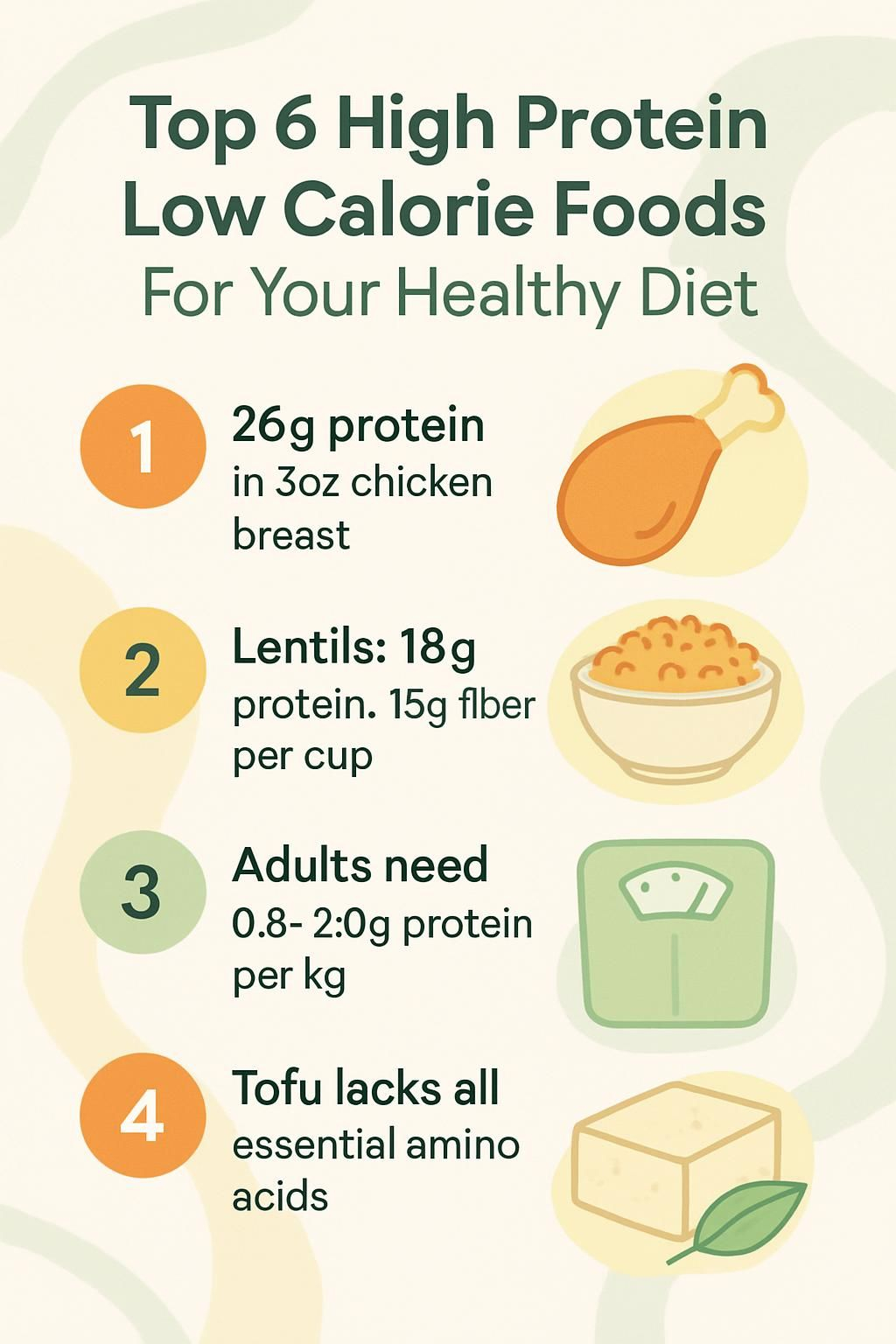
Why Choose High Protein, Low Calorie Foods?
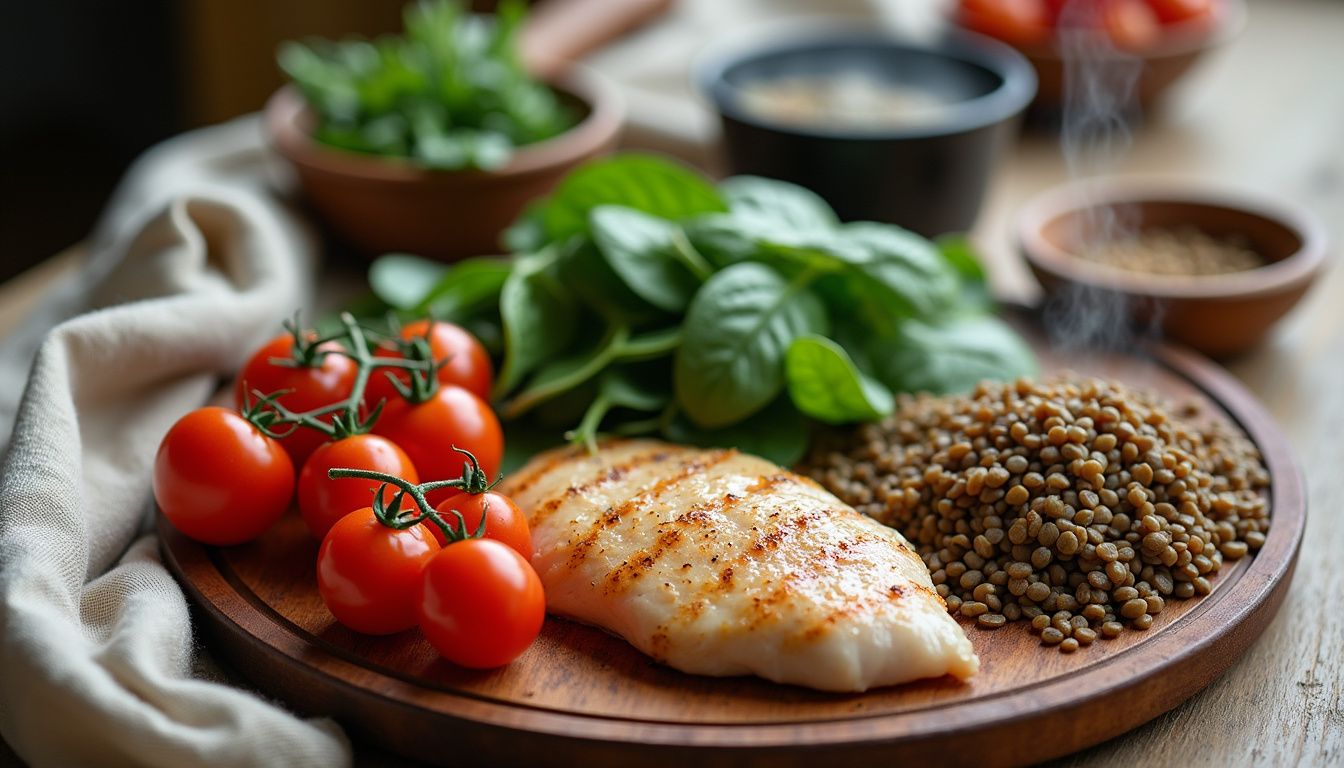
High protein, low calorie foods help with weight loss, preserve muscle, and support daily energy. They deliver nutrients without the extra fat and calories that can slow progress.
How Does Protein Help With Weight Management?
Protein helps control hunger by increasing fullness hormones and slowing digestion. Foods like chicken breast, egg whites, and Greek yogurt keep me satisfied, so I eat fewer snacks.
Higher protein intake can reduce daily calories on its own. For example, meals that provide about 30 percent of calories from protein have been linked with eating roughly 441 fewer calories per day in some studies [1]. Protein also raises calorie burn during digestion, a process called the thermic effect of food. About 20 to 30 percent of protein calories are used for digestion, compared with 5 to 10 percent for carbs and even less for fat [1].
Another advantage is muscle protection during weight loss. Muscle uses more calories at rest than fat, so keeping it supports your metabolism over time.
What Role Do Low-Calorie Foods Play in a Healthy Diet?
Low-calorie foods let me eat larger portions without overdoing calories. I focus on protein and fiber, like lentils or Greek yogurt, which curb hunger and make meals more satisfying.
These choices also help manage blood sugar and support heart health. Diets centered on vegetables, whole grains, and lean proteins are linked with a lower risk of obesity and heart disease [1].
Choosing meals low in fat and calories supports long-term health goals.
Compared with processed snacks or fatty meats, these foods are lower in saturated fat and cholesterol. Many are rich in vitamins, minerals, and antioxidants that protect your heart and overall health.
How to Add High Protein, Low Calorie Foods to Your Meals
I like to pair high protein foods with vegetables and whole grains. That mix keeps calories smart and protein intake steady across the day.
What Are Effective Strategies for Balanced Meals?
Simple habits make balanced eating easier for me. I set up each plate with protein, produce, and smart carbs.
- Include a protein source at every meal, such as skinless chicken breast, Greek yogurt, egg whites, lentils, tofu, or white fish.
- Fill half your plate with vegetables for fiber and key nutrients like folate, vitamin A, and iron.
- Pick whole grains, like brown rice or whole wheat bread, to support steady energy and pair well with beans or fish.
- Weigh or measure portions to track protein and calories with better accuracy.
- Use healthy fats, such as olive oil, avocado, or nuts, in small amounts for flavor.
- Plan ahead with prep for quick meals like grilled turkey salad or tofu stir-fry.
- Swap processed snacks for high-protein snacks, such as edamame or cottage cheese.
- Pair plant proteins with grains, like lentils with rice, to create complete proteins.
- Drink water regularly. A glass before meals can help with appetite control.
- Rotate simple recipes, like Greek yogurt parfaits or lemon baked salmon, to keep meals interesting.
What Are Easy Meal Prep Ideas?
Meal prep helps me hit my protein goal without stress. I mix animal and plant sources to keep variety and cost in check.
- Grill skinless chicken breast ahead, then slice for salads or wraps. Three ounces give about 26 grams of protein.
- Boil eggs, then keep egg whites for quick breakfasts or snacks. One white has about 3.6 grams of protein.
- Cook a big pot of lentil soup or salad. A half cup cooked has about 9 grams of protein.
- Stir Greek yogurt with berries for a fast parfait. A cup provides roughly 17 grams of protein plus calcium.
- Sauté tofu with mixed vegetables and light soy sauce for a plant-based stir-fry. Half a cup firm tofu has up to 10 grams of protein.
- Bake white fish like cod or tilapia in foil with lemon. A 4-ounce portion gives about 21 grams of complete protein.
- Portion cottage cheese into small containers for work snacks. A half cup has around 14 grams of protein.
- Steam edamame for the week. One cup supplies about 17 grams of plant protein and helpful minerals.
With these ideas ready, I can build higher protein plates in minutes on busy days.
Benefits of Skinless Chicken Breast
Skinless chicken breast is a lean protein that fits almost any plan. It is low in saturated fat and easy to cook in many ways.
What Are the Nutritional Benefits of Skinless Chicken Breast?
In a 100 gram serving, I get about 31 grams of protein and less than 3 grams of fat. There are essentially no carbs, which keeps calories lower than many cuts of beef or pork.
Chicken provides phosphorus, selenium, vitamin B6, and niacin. These nutrients support muscle, nerve function, and energy production. Since it gives a lot of protein per calorie, chicken breast helps me build or maintain lean muscle while managing weight.
This complete protein also makes it easier to meet daily nutrient needs through simple meals and snacks.
What Are the Best Ways to Prepare Skinless Chicken Breast?
Good technique keeps chicken juicy and flavorful without heavy sauces. Here are methods I use most often.
- Grill with olive oil spray, pepper, and garlic powder for flavor without extra calories.
- Bake at 375°F for 20 to 25 minutes after a yogurt, lemon, and herb marinade.
- Poach in low-sodium broth with onions and carrots for tender, moist results.
- Stir-fry diced chicken in a nonstick pan with broccoli or bell peppers and a little oil.
- Add sliced chicken to spinach, tomatoes, seeds, and cottage cheese for a protein-packed salad.
- Make a sheet pan dinner with asparagus or zucchini to simplify prep and cleanup.
- Shred cooked chicken for lettuce wraps or mix into a chickpea salad for easy lunches.
Health Benefits of Greek Yogurt
Greek yogurt is strained to remove liquid whey. That process increases protein and gives a thick, creamy texture that keeps me full.
What Nutrients Does Greek Yogurt Provide?
A 6-ounce serving usually delivers about 15 to 19 grams of protein, which is higher than many regular yogurts. It also provides calcium for bones and muscles, along with potassium and magnesium.
Each cup supplies vitamin B12 for nerve health and energy. Choosing low-fat or nonfat options cuts saturated fat while keeping the protein and minerals found in dairy.
What Foods Pair Well With Greek Yogurt for Meals and Snacks?
I use Greek yogurt in both sweet and savory snacks. These pairings add fiber, crunch, and flavor so I stay satisfied longer.
- Fresh berries like blueberries or strawberries add fiber and natural sweetness.
- Nuts such as almonds or walnuts bring protein and heart-friendly unsaturated fats.
- Sliced banana or diced apples increase volume and taste with few extra calories.
- Edamame on the side turns yogurt into a complete mini-meal with plant protein.
- Honey and chia seeds add omega-3s, fiber, and gentle sweetness before a workout.
- Granola, in small amounts, adds crunch. Choose lower sugar blends.
- Cucumbers, cherry tomatoes, or bell peppers pair well when I use yogurt as a veggie dip.
- Whole grain crackers make a quick base for a yogurt herb spread.
- Roasted chickpeas add extra plant protein and a crunchy topping.
These ideas turn Greek yogurt into a filling snack or light meal that supports weight goals.
Nutritional Advantages of Lentils
Lentils are legumes with protein, fiber, and minerals that support many eating patterns, including vegetarian and vegan diets. They are budget friendly and cook quickly compared with many beans.
What Are the Key Nutritional Facts About Lentils?
One cooked cup has about 18 grams of protein and around 230 calories. Lentils also provide complex carbohydrates, which digest slowly and keep me full.
They deliver about 15 grams of fiber per cup and contain iron, potassium, magnesium, zinc, and folate. Since they are plant based and shelf stable, lentils help me meet daily protein targets without animal products or powders.
I often pair lentils with vegetables, seafood, or whole grains to build meals with balanced flavors and nutrients.
How Can You Use Lentils Creatively in Soups and Salads?
Lentils are versatile. I use them warm or cold depending on the dish.
- Add cooked green or brown lentils to vegetable soup for more protein without many calories.
- Toss chilled lentils with cucumber, tomatoes, and chopped nuts for crunch and minerals.
- Combine warm lentils with spinach, red onion, and a little shredded cheese for a hearty bowl.
- Swap croutons with roasted lentils to boost protein compared with bread toppings.
- Simmer lentils with white fish or shrimp in a light broth for a high-protein soup.
- Spoon cooked lentils into lettuce wraps with herbs and citrus dressing for a light lunch.
- Serve marinated lentil salad next to grilled turkey or chicken for a balanced plate.
- Blend lentils as a creamy soup base in place of heavy cream to lower calories.
- Pair spiced lentils with a side of Greek yogurt for probiotics plus plant protein.
These swaps keep meals interesting while supporting a high-protein, low-calorie plan.
The Value of Egg Whites
Egg whites give high-quality protein with very few calories. They are easy to cook, mild in taste, and fit into most recipes.
What Nutrition Does Egg White Offer?
One large egg white has about 17 calories and nearly 4 grams of complete protein. It contains no fat and no cholesterol.
There are small amounts of potassium, magnesium, and riboflavin, a B vitamin. I often make an omelet with three egg whites for about 12 grams of protein and around 50 calories. That keeps me full without much fat or sugar.
What Are Quick and Easy Egg White Meal Ideas?
Egg whites cook fast, which makes them perfect for busy mornings or quick snacks.
- Scramble egg whites with spinach and tomatoes for a veggie-packed breakfast.
- Stir egg whites into oatmeal while it cooks to raise the protein.
- Whisk egg whites into vegetable soup for gentle ribbons of protein.
- Make an egg white omelet with lean turkey and bell pepper slices.
- Bake simple muffins using egg whites instead of whole eggs to cut fat.
- Prepare a frittata with egg whites, cooked vegetables, and fresh herbs.
- Use liquid egg whites as a binder in turkey meatballs or veggie burgers.
- Fold soft egg whites into cottage cheese and top with berries for a calcium-rich snack.
- Spoon fluffy microwaved egg whites over warm rice for a quick, filling bowl.
These ideas help me hit daily protein goals while keeping calories in check.
Tofu as a Versatile Protein Source
Tofu fits well in plant-based meals and supports heart health by replacing fattier meats. I use it weekly to add minerals and protein without many calories.
What Is the Nutrition Breakdown of Tofu?
A 100 gram serving of firm tofu provides about 8 grams of protein and roughly 70 to 80 calories. It supplies calcium, iron, magnesium, and phosphorus, which support bones and energy.
Tofu is low in saturated fat and contains no cholesterol. It also contributes small amounts of fiber and B vitamins like thiamin and folate. This balanced profile helps me feel full while supporting daily nutrient needs.
What Cooking Tips Help Incorporate Tofu in Plant-Based Diets?
Tofu absorbs flavors, which makes it easy to season well. These tips help me get the best texture and taste.
- Press tofu to remove excess water for better browning and firmer texture.
- Marinate at least 20 minutes with herbs, spices, or low-sodium soy sauce.
- Use extra-firm tofu for grilling or stir-frying so it holds shape under heat.
- Crumble firm tofu as a protein-rich swap for scrambled eggs or taco filling.
- Roast cubes at 400°F for about 25 minutes for a crispy salad topper.
- Blend silken tofu into smoothies or soups as a creamy, protein-rich thickener.
- Sauté tofu with broccoli, peppers, and carrots for colorful, high-protein, low-calorie meals.
- Combine tofu with lentils and leafy greens in grain bowls for meal prep.
- Pan-sear seasoned slices until golden for a simple main dish with steamed veggies.
Pressing first made the biggest difference for me. It helps every other method work better.
Protein Rich White Fish
White fish offers lean protein with a mild taste that pairs well with bold seasonings. It cooks quickly, which helps on weeknights.
What Is the Nutritional Profile of White Fish?
A 3 ounce serving usually contains about 20 grams of protein and fewer than 100 calories with under 1 gram of fat. Cod, haddock, tilapia, and pollock are common choices.
These species provide vitamin B12, niacin, phosphorus, and selenium. Sodium is moderate, about 60 to 90 milligrams per serving if I avoid added salt. White fish has less omega-3 than salmon, but it still contributes small amounts that support heart health.
Because it takes on flavors easily, I can create many dishes while keeping calories low.
How Can You Cook White Fish to Retain Nutrients?
Gentle, quick cooking helps keep protein quality and vitamins intact. These methods work well for me.
- Steam fillets for 5 to 10 minutes to lock in moisture and vitamins.
- Bake at 350°F for about 15 minutes, covered with foil to hold in juices.
- Poach gently in broth or water without boiling for up to 12 minutes.
- Grill over medium heat for 3 to 4 minutes per side, brushing lightly with oil.
- Sauté over moderate heat with a small amount of oil, turning once.
- Skip deep frying, which adds calories and can reduce heat-sensitive vitamins.
- Use fresh or frozen cod, haddock, pollock, or tilapia to maintain texture and nutrients.
Additional High Protein, Low Calorie Foods
I keep more high protein, low calorie foods on hand for variety. They help me stay consistent without getting bored.
What Are the Benefits of Edamame?
One cup of edamame offers about 18 grams of protein and around 189 calories. It is rich in fiber, which supports digestion and fullness, and provides folate, vitamin K, iron, and manganese.
Because soy is a complete protein, edamame supports both vegetarian and mixed diets. I steam it with a pinch of salt and eat the beans warm for a quick snack.
What Nutritional Benefits Does Cottage Cheese Have?
Each 100 gram serving of cottage cheese has about 11 grams of protein and fewer than 90 calories. It is rich in calcium for bones and provides B vitamins such as riboflavin and vitamin B12 for energy.
It also supplies phosphorus, selenium, and some potassium for muscle and immune function. I like it after workouts or before bed, because the slower-digesting casein protein supports overnight recovery.
How Does Turkey Breast Support a Healthy Diet?
Turkey breast is a lean protein with very few calories. A 3 ounce serving gives about 25 grams of protein and less than 2 grams of fat.
I use roasted turkey slices in salads or sandwiches to stay full without a calorie spike. Choosing lower sodium turkey supports heart health and blood pressure while providing vitamin B6 and niacin for metabolism.
FAQs on High Protein, Low Calorie Foods
These quick answers cover common questions I hear about high-protein choices and daily protein needs.
How Much Protein Do You Need Daily?
Most healthy adults need about 0.8 grams of protein per kilogram of body weight each day [1]. For a 150 pound person, that is roughly 54 grams.
Athletes and very active people may need 1.2 to 2.0 grams per kilogram to support training and recovery. I use a nutrition app to track my protein intake and keep calories in line using foods like chicken breast and Greek yogurt.
Are Plant-Based Proteins as Nutritious as Animal Proteins?
Plant proteins such as lentils, tofu, and edamame provide protein plus fiber and antioxidants. That is a mix often missing in meat and fish.
Most plant proteins are not complete on their own, except soy and quinoa. I build complete proteins by pairing different foods across the day, like beans with rice. Animal proteins provide vitamin B12, heme iron, and zinc more easily. On a vegan diet, I plan carefully or consider supplements with a registered dietitian if needed.
To boost intake without extra calories, I combine plant proteins with vegetables for balanced meals.
Simple Recipes with High Protein, Low Calorie Foods
These recipes are fast, affordable, and sized for everyday cooking. I repeat them often because they taste good and meet my protein goals.
How Do You Make Grilled Chicken and Lentil Salad?
This salad is loaded with protein and fiber. It keeps well for lunch the next day.
- Grill 4 ounces of skinless chicken breast over medium heat for 6 to 7 minutes per side. Slice into strips.
- Simmer 1/2 cup dry lentils for 20 to 25 minutes until tender. Drain well.
- Toss mixed greens, cherry tomatoes, cucumbers, and thin red onions in a large bowl.
- Add warm lentils and grilled chicken. Mix gently so pieces stay intact.
- Drizzle 1 tablespoon olive oil and lemon juice. Add a pinch of salt and pepper.
- Top with chopped parsley or cilantro for color and freshness.
- Serve chilled or at room temperature for a high-protein, low-calorie meal.
What Is the Recipe for Greek Yogurt and Berry Parfait?
This parfait works as breakfast or a snack. It comes together in minutes and keeps me full.
- Spoon 3/4 cup plain nonfat Greek yogurt into a glass or bowl.
- Layer 1/2 cup mixed berries over the yogurt.
- Sprinkle 1 tablespoon chia seeds for extra protein and fiber.
- Add 1 teaspoon honey or agave for light sweetness, if desired.
- Repeat the yogurt, berries, chia, and sweetener for a second layer.
- Top with 2 tablespoons sliced almonds or walnuts for crunch and healthy fats.
- Eat right away or chill up to two hours for softer layers.
How Do You Prepare a Tofu and Vegetable Stir-Fry?
This stir-fry is a simple way to eat more plant protein. I change the vegetables based on what I have.
- Choose extra-firm tofu. A 1/2 cup serving has about 10 grams of protein.
- Press tofu for at least 15 minutes to remove moisture.
- Cut into cubes and season with low-sodium soy sauce or spices.
- Heat 1 tablespoon olive oil in a large skillet over medium-high heat. Brown tofu on all sides.
- Add chopped broccoli, bell peppers, carrots, or snap peas.
- Cook vegetables 5 to 7 minutes until crisp-tender to preserve nutrients.
- Return tofu to the pan. Toss with a light sauce of ginger, garlic, and a touch of sesame oil.
- Serve hot. Finish with green onions or sesame seeds.
Avoiding Pitfalls in High Protein Diets
High-protein eating can be very effective. I stay mindful of processed items and aim for balance on every plate.
What Are the Risks of Overeating Processed Protein Foods?
Protein bars, shakes, and packaged snacks can be high in sodium, unhealthy fats, and added sugars. Eating a lot of them may raise blood pressure and increase heart disease risk.
These items often lack fiber and essential vitamins, which makes a balanced diet harder. I feel fuller longer with whole foods like grilled chicken breast or Greek yogurt compared with processed snacks.
Choosing mostly whole food proteins helps reduce digestive issues and improves satiety.
Why Is Maintaining a Balanced Diet Important?
Relying on processed protein foods can crowd out vegetables, fruits, and whole grains. That pattern raises sodium and fat while lowering fiber, vitamins, and minerals your body needs.
I build plates with vegetables, whole grains, lean meats such as turkey breast, Greek yogurt, and plant proteins like lentils or tofu. Research supports that balanced eating strengthens the immune system and steadies energy during the day [1].
If you have a medical condition, talk with a healthcare professional or registered dietitian before making big diet changes.
Conclusion
High protein low calorie foods, such as skinless chicken breast, Greek yogurt, lentils, egg whites, tofu, and white fish, make it easier to manage weight and protect muscle. These staples help me cook balanced meals that keep me satisfied, energized, and on track with a healthy diet.
Try one or two new ideas this week and see how you feel. Small changes add up fast when each meal has a strong protein source and smart calories.
References: [1] USDA Dietary Guidelines for Americans 2020-2025; U.S. Department of Agriculture, FoodData Central for nutrient values; Academy of Nutrition and Dietetics, position statements on protein and weight management.
FAQs
1. What are the top six high protein low calorie foods for a healthy diet?
Egg whites, skinless chicken breast, cod fillets, Greek yogurt (nonfat), cottage cheese (low-fat), and tofu provide high protein with few calories. These foods support muscle growth and help manage weight. According to the USDA FoodData Central database, each of these options contains at least 10 grams of protein per serving while staying under 120 calories.
2. How do these foods support weight management?
High protein low calorie foods increase satiety and preserve lean body mass during calorie restriction. A study published in The American Journal of Clinical Nutrition found that higher dietary protein intake can reduce hunger levels and promote fat loss when compared to lower-protein diets.
3. Can I include these foods in different meals throughout the day?
Yes; you can add egg whites to breakfast omelets or stir tofu into vegetable stir-fries for lunch or dinner. Greek yogurt makes a nutritious snack while cottage cheese pairs well with fruit as an evening meal addition. Skinless chicken breast works well grilled or baked alongside vegetables.
4. Are there any personal tips for adding more high protein low calorie foods to my daily routine?
Swapping regular snacks for nonfat dairy products helped me feel full longer between meals without extra calories from fat or sugar. Preparing several servings of cooked chicken breast ahead of time made it easy to build balanced lunches quickly during busy weeks.
Summary: Choosing egg whites, skinless poultry cuts, white fish like cod, nonfat cultured milk products such as Greek yogurt and cottage cheese, plus plant-based proteins like tofu offers reliable ways to boost your daily protein intake without excess calories according to research-backed sources and practical experience alike.

